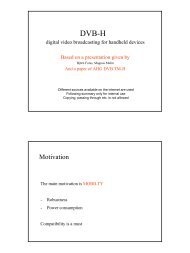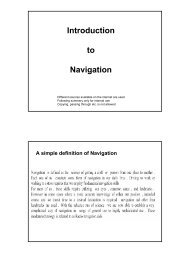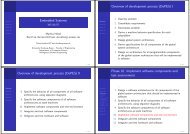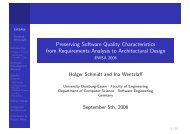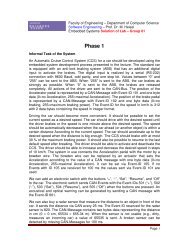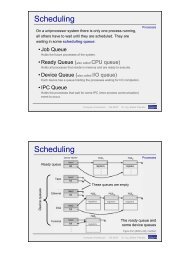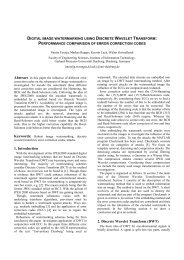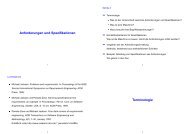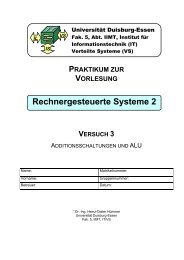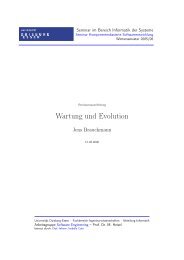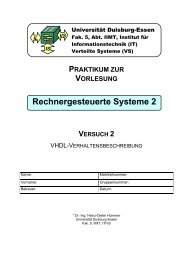Slides Part 2 (OOA, pages 1-128, pdf, 4 slides per page)
Slides Part 2 (OOA, pages 1-128, pdf, 4 slides per page)
Slides Part 2 (OOA, pages 1-128, pdf, 4 slides per page)
You also want an ePaper? Increase the reach of your titles
YUMPU automatically turns print PDFs into web optimized ePapers that Google loves.
O<strong>per</strong>ation = application not accepted<br />
Description = An application is rejected by the central office.<br />
Reads = supplied app nr : Appl nr<br />
client : Client with (client, application) ∈ PreparesAppl<br />
product : Product with (application, product) ∈ ForAppl<br />
Changes = delete application : Application with<br />
application.nr = app nr<br />
PreparesAppl, ForAppl<br />
Sends = Employee: {contract not prepared(app nr)}<br />
Pre = exists application : Application with application.nr = app nr<br />
Post = ForAppl ′ = ForAppl \{(application, product)}<br />
THE SYSTEM CLASS MODEL<br />
PreparesAppl ′ = PreparesAppl \{(client, application)}<br />
is sent{contract not prepared(app nr)}<br />
105<br />
➠ Shows the classes to be implemented.<br />
➠ Is developed from a part of the class model.<br />
➠ Is delineated by a dashed line.<br />
➠ Actors and non-implementable classes (e.g., <strong>per</strong>sons who do not directly<br />
interact with the system) do not belong to the system class model.<br />
➠ The interpretation of a class can change from “real object” to “data<br />
representation”.<br />
➠ Classes on the system border may be divided into internal and external<br />
classes.<br />
107<br />
OBJECT-ORIENTED ANALYSIS<br />
➠ Class model =⇒ Static aspects<br />
➠ Interface model =⇒ Dynamic aspects<br />
• Use case model<br />
• Scenarios<br />
• O<strong>per</strong>ation model<br />
• System class model<br />
• Life-Cycle model<br />
➠ Usually, additions to the class model are necessary by:<br />
106<br />
• attributes that are introduced when setting up the o<strong>per</strong>ation model<br />
• “communication classes” for actors, i.e., classes that receive the system<br />
o<strong>per</strong>ations (see OOD)<br />
➠ The system class model is a well-formed class model, i.e., an association<br />
only belongs to it if all concerned classes are inside the system.<br />
108



